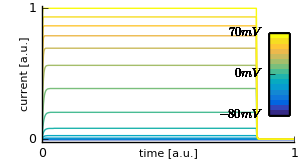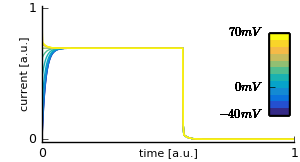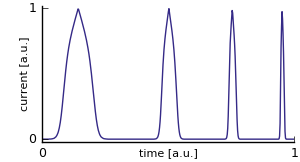Channel 195667-kv
General data
- ICG id: 4461
- ModelDB id: 195667
- Reference: Eyal G, Verhoog MB, Testa-Silva G, Deitcher Y, Lodder JC, Benavides-Piccione R, Morales J, DeFelipe J, de Kock CP, Mansvelder HD, Segev I (2016): Unique membrane properties and enhanced signal processing in human neocortical neurons.
Metadata classes
- Animal Model: human
- Brain Area: cortex
- Neuron Region: unspecified
- Neuron Type: pyramidal cell
- Subtype: HH
Metadata generic
- Age: 32–43 years old
- Authors: Eyal G, Verhoog MB, Testa-Silva G, Deitcher Y, Lodder JC, Benavides-Piccione R, Morales J, DeFelipe J, de Kock CP, Mansvelder HD, Segev I
- Comments: COMMENT kv.mod Potassium channel, Hodgkin-Huxley style kinetics Kinetic rates based roughly on Sah et al. and Hamill et al. (1991) Author: Zach Mainen, Salk Institute, 1995, zach@salk.edu 26 Ago 2002 Modification of original channel to allow variable time step and to correct an initialization error. Done by Michael Hines(michael.hines@yale.e) and Ruggero Scorcioni(rscorcio@gmu.edu) at EU Advance Course in Computational Neuroscience. Obidos, Portugal 20110202 made threadsafe by Ted Carnevale 20120514 fixed singularity in PROCEDURE rates Special comment: This mechanism was designed to be run at a single operating temperature--37 deg C--which can be specified by the hoc assignment statement celsius = 37 This mechanism is not intended to be used at other temperatures, or to investigate the effects of temperature changes. Zach Mainen created this particular model by adapting conductances from lower temperature to run at higher temperature, and found it necessary to reduce the temperature sensitivity of spike amplitude and time course. He accomplished this by increasing the net ionic conductance through the heuristic of changing the standard HH formula g = gbar*product_of_gating_variables to g = tadj*gbar*product_of_gating_variables where tadj = q10^((celsius - temp)/10) temp is the "reference temperature" (at which the gating variable time constants were originally determined) celsius is the "operating temperature" Users should note that this is equivalent to changing the channel density from gbar at the "reference temperature" temp (the temperature at which the at which the gating variable time constants were originally determined) to tadj*gbar at the "operating temperature" celsius. ENDCOMMENT
- Temperature: q10=2.3, tadj = q10^((celsius - temp)/(10 (degC)))
Current Response Traces
Activation

Inactivation

Deactivation

Action Potential

Ramp
